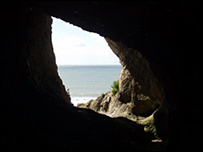 |
The burial site was in Goat's Hole Cave at Paviland on Gower

|
The Red Lady of Paviland has always been a little coy about her age - but it appears she may be 4,000 years older than previously thought. Scientists say more accurate tests date the earliest human burial found in the UK to just over 29,000 years ago.
When discovered in a cave on Gower in the 1820s the bones were thought to be around 18,000 years old, but were later redated to between 25,000 and 26,000.
Researchers said it casts a new light on human presence in western Europe.
The team from Oxford University and the British Museum said new dating techniques provided more accurate results.
The skeleton of the Red Lady - actually a young male - was discovered at Goat's Hole Cave at Paviland on Gower in 1823 by William Buckland, then a geology professor at Oxford University.
It owes its name to the red ochre covering the bones.
Dr Thomas Higham of Oxford University said he and his colleague Dr Roger Jacobi of the British Museum had now done further tests and were "confident" of the new results.
The remains were found along with a number of artefacts including ivory wands, bracelets and periwinkle shells.

The cave skeleton was found by William Buckland
|
"The remains and artefacts were previously difficult to date accurately," said Dr Higham.
"Many of the bones were treated with preservations in the 19th Century and some of this contamination is often difficult to remove."
He said their analysis was the bones were "just over" 29,000 years old.
It would mean The Red Lady lived in an age when the climate was much warmer than it would have been 4,000 years later.
Dr Higham added: "The data that we have got now is making a lot more sense."
He said it was important for "our understanding of the presence and behaviour of humans in this part of the world at this time".
He also said it "might" suggest that the custom of burying people with artefacts originated in western Europe rather than eastern Europe as had previously been thought.
"This raises new questions about the way in which these people spread and lived on the continent," he added.
The remains of the Red Lady are to form part of a new exhibition opening at the National Museum Wales in Cardiff in December.


~RS~q~RS~~RS~z~RS~22~RS~)
Bookmark with:
What are these?